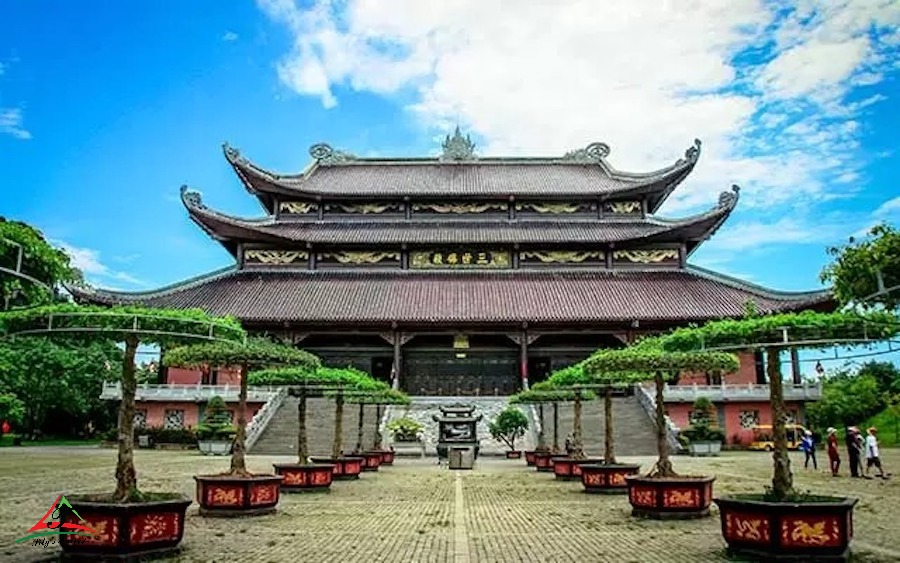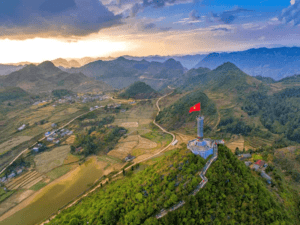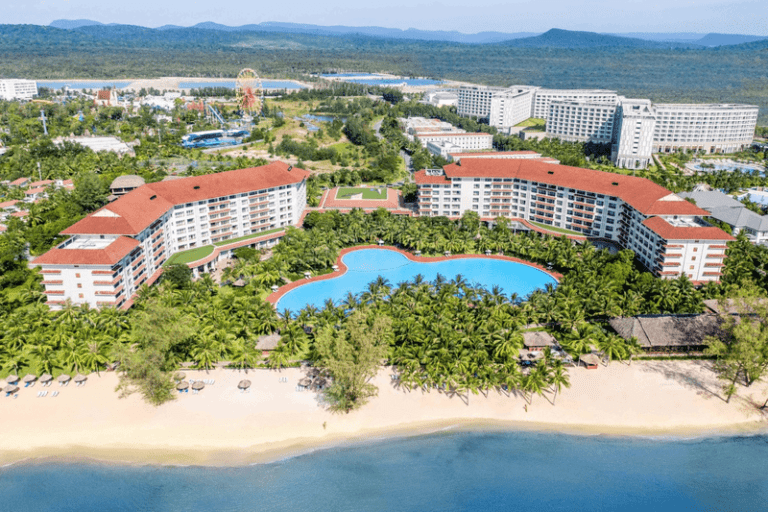Bai Dinh Pagoda history always attracts many tourists. Bai Dinh Pagoda is a spiritual attraction that is to be noticed by domestic and international tourists. Bai Dinh Pagoda complex has an area of 539 hectares, a temple associated with many world records you may not know.

The historical imprint of ancient Bai Dinh pagoda

Bai Dinh Pagoda started construction in 2003, but it is a new temple. Bai Dinh has 2 areas, the old and new pagoda areas. The ancient pagoda is located in the mountain behind the new pagoda area, a mysterious spiritual place with a history dating back more than 1000 years. Zen master Nguyen Minh Khong founded it. Also, at the place where the ancient Bai Dinh Pagoda resides, in the past, King Dinh Tien Hoang once set up an altar to pray for good weather and wind. Later, King Quang Trung chose this place to sacrifice flags to encourage soldiers before going to Thang Long to destroy the Qing army.
When visiting the pagoda, King Le Thanh Tong carved a Chinese poem praising the beauty of this place. The poem has a translation: “The mountain has a very high reputation/ Protects the capital from the ancient land/ The outstanding people of the land should be prosperous/ The sacred mountains have beautiful and stable mountains and rivers.” During the resistance war against the French and Japanese, the pagoda was an essential revolutionary base in North Vietnam.
Architecture of ancient Bai Dinh pagoda

Ancient Bai Dinh Pagoda bears the architectural style of the Ly Dynasty. The pagoda does not have curved roofs, enormous, massive pillars, or a magnificent upper hall. Still, it is built in the famous cave pagoda architecture like other ancient pagodas in Ninh Binh. To visit the cave in Bai Dinh Mountain, you have to take 300 stone steps through the three-entrance gate halfway up the hill. Go up the slope to reach the fork: on the right is a light cave worshiping Buddha and Gods, and on the left is a dark cave worshiping Mother Goddesses and Fairies.
The dark cave consists of 7 chambers; some are high, and some are deep. The caves are connected through many rock crevices. This is the place to worship Mother Goddesses and Fairies. In Dark Cave, a jade well is created by cold water falling from the cave ceiling. The Bai Dinh pagoda’s system caverns include the Dark Cave region and the Bright Cave, where Buddha is revered. The Buddha worship cave at the historic Bai Dinh Pagoda is 25 meters long and 2 meters high. Over the years, the cave ceilings have solidified into pagoda roofs, sheltering the sacred sites of Buddha and Mother Goddesses. Statues are positioned decoratively and sacredly throughout Sang Cave.
Going to the end of Sang cave will lead to a lush green valley, going all the way to the stone steps to reveal the temple of Cao Son God. The temple was built with its back against the mountain and is a place to worship the god who governs the Vu Lam mountain region south of the ancient capital – Hoa Lu.
New Bai Dinh Pagoda – New Pagoda with the new decoration and contracture
Bai Dinh ancient pagoda is located at the Tam The Palace of the new pagoda area about 800m southeast, along the slopes of Dinh mountain. The pagoda is located on the top of the hill, below is a tranquil natural forest. To visit ancient Bai Dinh, visitors must step on 300 stone steps up the slope to reach the junction where Saint Nguyen temple is located; on the right is a light cave worshiping Buddha, and on the left is a dark cave worshiping Mother Goddesses. Each cave has its own story and legend, creating mysterious and sacred features at the meditation gate.
The new Bai Dinh pagoda area has an area of 80 hectares located on the other side of the mountain from the old pagoda area. It is a large project with many items such as Tam The Palace, Phap Chu Palace, Quan The Am Palace, Stupa, Bell Tower and massive underground works built in many different stages.
Bai Dinh Pagoda is unique with remarkable things you may not know:
Unique architecture in Bai Dinh Pagoda

The pagoda was built with outstanding architectural style, with large and majestic cubes bearing a solid Vietnamese impression. The primary materials used in creating the pagoda are Ninh Van – Ninh Binh green stone, Tu Thiet wood, Bat Trang glazed tiles. The phoenix tail and decorative details also represent famous traditional Vietnamese craft villages. Bai Dinh Pagoda was built according to the internal and external structures: a rectangle surrounded by four sides. When standing at the Tam Quan gate and looking up, all the works are one after another, higher than each other, culminating in Tam The Palace, which is both the starting and ending points of an orderly architectural complex.
Vietnam’s proud spiritual tourist area
Bai Dinh Pagoda is a proud spiritual tourist destination of the Vietnamese people, with many works recognized as Asian records, such as:
- The pagoda has the largest bronze bell in Vietnam: The Dai Hong Chung; this bell weighs 36 tons, is 5.5m high, and has a diameter of 3.7m placed in the Bell Tower. The bell is cast entirely from red bronze in Nam Dinh; on the body, many patterns and motifs are simulated from ancient bells, prominently featuring Chinese characters engraved with Buddhist themes.
- The giant gold-plated bronze Buddha statue in Asia, the statue of Shakyamuni Buddha sitting on a lotus in the main hall of the temple’s Dharma Master Temple, has been recognized by the Asian Records Center as the gold-plated bronze Buddha statue—the most significant gold in the entire continent. The statue is 10m high, weighs 100 tons, is made of pure bronze plated with gold, is placed on a 1.5m high pedestal, and is one of the symbols of Bai Dinh Pagoda.
- The giant bronze Maitreya Buddha statue in Southeast Asia: Resting on a hill to the right of the Tam, The Buddha shrine of Bai Dinh pagoda is recognized by the Vietnam Record Book Center – Vietkings as the Maitreya statue—the country’s largest. The area where the 10m high, 80-ton bronze statue is located is a famous photo spot in Ninh Binh for tourists.
- Asia’s tallest Stupa: Located west of Tam The Palace in the new Bai Dinh pagoda area, Xa Loi Stupa includes 13 tower floors with a hexagonal circumference of 24m and a height of 99m – a symbolic number for eternity, goodness, and luck. The stupa was designed and built in an utterly Vietnamese style, with architecture bearing the Buddhist imprint of the Ly Dynasty. The tower’s top floor is a place to preserve and worship Buddha’s relics that were welcomed from India and Burma.

- The largest pagoda area in Vietnam (as of 2010) has a total area of up to 539 hectares (the old pagoda is 27 hectares, and the new pagoda complex is 80 hectares).
- The pagoda has the longest Arhat corridor in Asia: The Arhat corridor of Bai Dinh Pagoda is nearly 3km long, displaying stone statues of Arhats. From the Tam Quan wooden house along the East and West directions to the Left and Right Vu pagodas, each side has 117 corridors. Each Arhat corridor at Bai Dinh Pagoda has architecture from low to high with 22 steps; each step is 1.35m high, built entirely of wood.
- The pagoda has the most Arhat statues in Vietnam: There are up to 500 monolithic Arhat statues from 1.5m to 2m high along the Arhat corridor, carved softly and delicately. More specifically, each statue has a different face shape and standing and sitting posture. Even the Arhats’ expressions were exciting.
- The pagoda area has the largest Jade well in Vietnam: The Jade Well of Bai Dinh pagoda has just been rebuilt at the old Jade well location near the foot of Bai Dinh mountain, associated with a miraculous story nearly 1,000 years ago when Zen master Nguyen Minh Khong took water from the well to make medicine to cure people’s illnesses. The well is moon-shaped, 30m in diameter, 6m deep and especially never runs out of water. This place was honored to be recognized by the Vietnam Record Book Center in 2007.
- The pagoda has the most significant number of Bodhi trees in Vietnam: 100 Bodhi trees extracted from Indian tree roots. Each Bodhi tree is planted by a Party and State leader and a nameplate is attached to the stone stele. Rows of Bodhi trees radiate cool green shade, creating a beautiful landscape for the Bai Dinh pagoda complex.

Read more: Am Tien cave: Discover the charming young beauty only in Ninh Binh Province (Part 1)
The appeal of Bai Dinh Pagoda to foreign tourists
Thanks to Bai Dinh Pagoda, Ninh Binh Province become more attractive. With a system of attractions and experiences suitable for tourists on spring trips at the beginning of the year, Ninh Binh is one of the destinations with solid growth during the seven days of the Lunar New Year 2024. According to a report from the Ninh Binh Department of Tourism on February 14, on the 4th day of Tet alone, this province welcomed more than 209,000 visitors, including over 35,000 international visitors and more than 174,000 domestic visitors.
From the 29th day of Tet to the 5th day of Tet, Ninh Binh tourism is estimated to welcome 596,000 visitors, an increase of 50.1% compared to Tet 2023. Bai Dinh Pagoda has the most significant number of visitors, with 170,000 visitors, followed by Trang An tourist area, Hoa Lu ancient town… Room occupancy during Tet at many accommodation establishments in Ninh Binh reached 80-85% on the evenings from the 3rd to the 5th of Tet.
On the 4th and 5th days of Tet, there are many tourist attractions visitors but no jostling or pushing. Many attractive activities are organized throughout the holiday season to provide more experiences for visitors to Ninh Binh. Besides exploring Bai Dinh Pagoda, many people visit Hoa Lu, an ancient town that organizes a music program and fireworks display to welcome the new year at Thuy Dinh stage. Thung Nham eco-tourism area has a program called “Recovering old Tet memories,” with many activities such as art space, Traditional arts, fun activities for Thai and Muong Tet (winemaking, men men, sticky rice, weaving, folk games)… on the evening of the 3rd, 4th, 5th day of The Lunar New Year.
Looking from above, we can feel the Bai Dinh pagoda complex with what has been created, contributing to the surrounding space with the immense lake and mountains in the distance; the pagoda seems to lean on Dinh mountain. Into a very generous and overwhelming space, but arranged in a tight, reasonable way and as if in harmony with the nature here. Lilys’ Travel is honored to come with you to enjoy this unique temple!
Read more: Ninh Binh Tour















